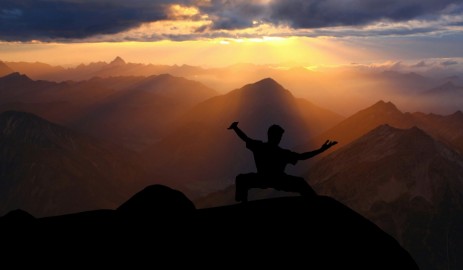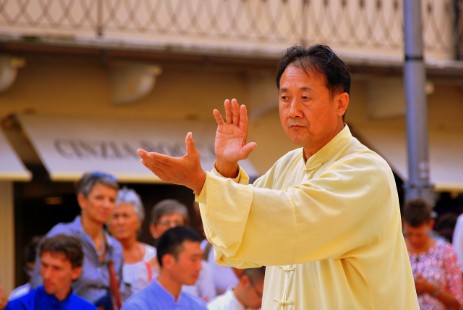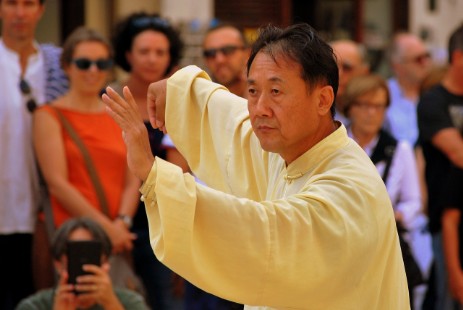Tai chi
By the way of the movement, which is usually carried out slowly, evenly and fluently, the exerciser will gradually relax. The breathing becomes slower, calmer and deeper. After prolonged practice, body and mind become more mobile. The joint positions are optimized and the posture improves increasingly. Traditionally, this is also known as "oiling the joints".
Tai Chi strengthens bones, muscles, tendons and ligaments. Parkinson's disease has been shown in a New England Journal of Medicine study to reduce the incidence of falls already after 24 weeks of regular Tai Chi practice.
The meditative aspect of practicing clarifies the mind. The "deceleration" of the movements combined with deep, natural breathing (diaphragmatic or abdominal breathing) and the associated deep relaxation have a very positive effect on the nervous system and improve the metabolism among other things by the increased oxygen content in blood and tissue. The practitioner feels more relaxed.
Tai Chi has a balancing effect on the practitioner and leads to more health, vitality, fitness and life joy. These effects can set themselves after a short period of regular practice and increasingly intensify.
Tai Chi strengthens bones, muscles, tendons and ligaments. Parkinson's disease has been shown in a New England Journal of Medicine study to reduce the incidence of falls already after 24 weeks of regular Tai Chi practice.
The meditative aspect of practicing clarifies the mind. The "deceleration" of the movements combined with deep, natural breathing (diaphragmatic or abdominal breathing) and the associated deep relaxation have a very positive effect on the nervous system and improve the metabolism among other things by the increased oxygen content in blood and tissue. The practitioner feels more relaxed.
Tai Chi has a balancing effect on the practitioner and leads to more health, vitality, fitness and life joy. These effects can set themselves after a short period of regular practice and increasingly intensify.

Philosophy of Tai Chi
The "Chi" in Tai Chi is an all-encompassing energy. This
vital energy, also called Qi in Traditional Chinese Medicine (TCM), is
to be strengthened through regular practice, through:
- Body perception and control
- Relaxation by breathing and flowing movements
- inner harmony



What does Tai Chi form mean?
The sequence of individual Tai Chi exercises (movements, positions, figures, pictures) is called a form. She (a form) accompanies the Tai Chi practitioners throughout the time. In practicing the movements, the principles underlying each form are repeatedly practiced and internalized.
Tai Chi has several main styles and many minor styles. The movement sequences are correspondingly different: Depending on the style, a shape is sometimes executed with expansive, sometimes with smaller movements in different heights.
Short form
Originally there were only long forms in Tai Chi, which could take up to one and a half hours to complete, depending on the design. However, as fewer and fewer people find the time to learn such complex movements, so-called short forms have been developed in the last century, varying in duration from 5 to 15 minutes, making tai chi accessible to a wider audience. The best known are probably the 37 positions according to Prof. Cheng Man Ching and the 24er-Beijing form. In addition to the short and long forms, there are also partner and weapon forms.
Originally there were only long forms in Tai Chi, which could take up to one and a half hours to complete, depending on the design. However, as fewer and fewer people find the time to learn such complex movements, so-called short forms have been developed in the last century, varying in duration from 5 to 15 minutes, making tai chi accessible to a wider audience. The best known are probably the 37 positions according to Prof. Cheng Man Ching and the 24er-Beijing form. In addition to the short and long forms, there are also partner and weapon forms.

For what Tai Chi
Tai Chi Chuan is used in TCM for health promotion and maintenance. The
exercises are designed to activate the self-healing powers, reduce
general and chronic fatigue, reduce musculoskeletal limitations and
strengthen the immune system.
Since in the Tai Chi exercises the joint position is always aligned to a good body statics, the muscles can work optimally. The body comes into balance and can relax. The deliberate, deep breathing in the abdomen should also "turn off" the head.
Studies show that Tai Chi can maintain muscle strength and increase physical capacity (strength, flexibility, endurance). "Especially for people who suffer from multiple diseases, Tai Chi could be a good alternative for gentle exercise," concludes a Canadian meta-study of more than 21 studies on the subject.
Since in the Tai Chi exercises the joint position is always aligned to a good body statics, the muscles can work optimally. The body comes into balance and can relax. The deliberate, deep breathing in the abdomen should also "turn off" the head.
Studies show that Tai Chi can maintain muscle strength and increase physical capacity (strength, flexibility, endurance). "Especially for people who suffer from multiple diseases, Tai Chi could be a good alternative for gentle exercise," concludes a Canadian meta-study of more than 21 studies on the subject.

Do you want to get to know Tai-Chi?
You can sign up here
You can sign up here






